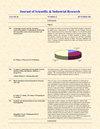A A Novel BCI - based Silent Speech Recognition using Hybrid Feature Extraction Techniques and Integrated Stacking Classifier
IF 0.8
4区 工程技术
Q3 ENGINEERING, MULTIDISCIPLINARY
引用次数: 0
Abstract
The Brain Computing Interface (BCI) is a technology that has resulted in the advancement of Neuro-Prosthetics applications. BCI establishes a connection between the brain and a computer system, primarily focusing on assisting, enhancing, or restoring human cognitive and sensory - motor functions. BCI technology enables the acquisition of Electroencephalography (EEG) signals from the human brain. This research concentrates on analyzing the articulatory aspects, including Wernicke's and Broca's areas, for Silent Speech Recognition. Silent Speech Interfaces (SSI) offers an alternative to conventional speech interfaces that rely on acoustic signals. Silent Speech refers to the process of communicating speech in the absence of audible and intelligible acoustic signals. The primary objective of this study is to propose a classifier model for phoneme classification. The input signal undergoes preprocessing, and feature extraction is carried out using traditional methods such as Mel Frequency Cepstrum Coefficients (MFCC), Mel Frequency Spectral Coefficients (MFSC), and Linear Predictive Coding (LPC). The selection of the best features is based on classification accuracy for a subject and is implemented using the Integrated Stacking Classifier. The Integrated Stacking Classifier outperforms other traditional classifiers, achieving an average accuracy of 75% for both thinking and speaking states on the KaraOne dataset and approximately 86.2% and 84.09% for thinking and speaking states on the Fourteen Channel EEG for Imagined Speech (FEIS) dataset.一种基于脑机接口的基于混合特征提取技术和集成堆叠分类器的无声语音识别方法
脑计算接口(BCI)是一项导致神经修复应用进步的技术。脑机接口建立了大脑和计算机系统之间的连接,主要集中于协助、增强或恢复人类的认知和感觉运动功能。脑机接口技术能够从人脑中获取脑电图(EEG)信号。本研究集中分析无声语音识别的发音方面,包括Wernicke和Broca区域。无声语音接口(SSI)提供了一种替代依赖声信号的传统语音接口的方法。无声言语是指在没有可听和可理解的声音信号的情况下进行言语交流的过程。本研究的主要目的是提出一个音素分类的分类器模型。对输入信号进行预处理,并使用Mel频率倒谱系数(MFCC)、Mel频谱系数(MFSC)和线性预测编码(LPC)等传统方法进行特征提取。最佳特征的选择基于主题的分类精度,并使用集成堆叠分类器实现。集成堆叠分类器优于其他传统分类器,在KaraOne数据集上对思维和说话状态的平均准确率为75%,在14通道想象语音EEG (FEIS)数据集上对思维和说话状态的平均准确率约为86.2%和84.09%。
本文章由计算机程序翻译,如有差异,请以英文原文为准。
求助全文
约1分钟内获得全文
求助全文
来源期刊

Journal of Scientific & Industrial Research
工程技术-工程:综合
CiteScore
1.70
自引率
16.70%
发文量
99
审稿时长
4-8 weeks
期刊介绍:
This oldest journal of NISCAIR (started in 1942) carries comprehensive reviews in different fields of science & technology (S&T), including industry, original articles, short communications and case studies, on various facets of industrial development, industrial research, technology management, technology forecasting, instrumentation and analytical techniques, specially of direct relevance to industrial entrepreneurs, debates on key industrial issues, editorials/technical commentaries, reports on S&T conferences, extensive book reviews and various industry related announcements.It covers all facets of industrial development.
 求助内容:
求助内容: 应助结果提醒方式:
应助结果提醒方式:


